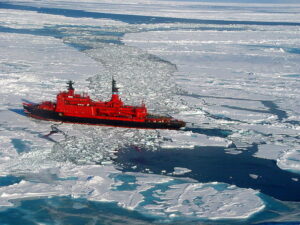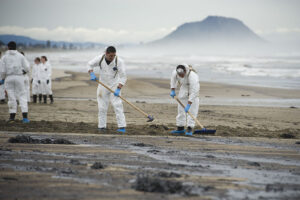Reviewing: Schreiber, L., Hunnie, B., Altshuler, I., Góngora, E., Ellis, M., Maynard, C., … & Greer, C. W. (2023). Long-term biodegradation of crude oil in high-arctic backshore sediments: The Baffin Island oil spill (BIOS) after nearly four decades. Environmental Research, 116421.

Oil has been the primary source of energy for the past century. As we continuously search for untapped oil reserves to fuel our economy, many have been turning their attention to the Arctic. The US Geological Survey estimates that the Arctic holds up to a fifth of the world’s undiscovered oil reserves. These resources have been left untouched, since the harsh climate conditions in the Arctic make exploring and developing oil reserves very challenging. But oil exploration in the Arctic is becoming more accessible with the Arctic warming up and losing sea ice. Commercial ships that use and transport oil are also traveling throughout the Arctic waters more often, increasing the risk of oil spills in the Arctic. Unfortunately, we know very little about the potential impacts of oil spills in the Arctic.
When you think of oil spills, images of volunteers walking along the beach and scooping out oil-drenched sands may come to mind. These actions are definitely helpful to minimize the damage of oil spills. But oil in the environment also degrades naturally, just over much longer periods of time. Oil-eating microbes living in seawater and in soil can take up oil and break it down to smaller molecules that are not harmful anymore to the environment. However, to break down oil effectively, these microbes need to have “nice” living conditions (warm water temperature, lots of nutrients in water, etc.), which the Arctic waters don’t really offer. This had motivated a group of scientists in the early 1980s to study how oil degrades naturally in the Arctic climate, by carrying out the Baffin Island Oil Spill (BIOS) project. In this project, they had released a small amount of crude oil on two nearshore locations in the Arctic to simulate real oil spill events, and tracked how the composition of oil changed over time.

In 2019, another group of scientists revisited the BIOS project sites to find out what impacts the oil spills from four decades ago left on the beaches of Baffin Island. They collected beach sand at the surface (0-2cm) and the subsurface (slightly below the surface, 5-10cm) from the oil spill sites, and also from uncontaminated sites. Even though sands from the oil spill sites did not look different from oil-free sands by eye, there was still 0-2% and 3-6% of crude oil left in the surface and the subsurface sands after all these years.

The scientists also discovered that there were still large differences in the populations and types of microbes living in oil-contaminated sands compared to oil-free sands. Because oil-contaminated sands were providing extra nutrients only for oil-eating microbes, oil-contaminated sands contained mostly oil-eating microbes, whereas oil-free sands contained many more types of diverse microbes. This meant that the sands affected by oil still haven’t returned to their original state!
Interestingly, most of the oil-eating microbes were not specifically adapted to the cold temperatures in the Arctic. This means that oil-eating bacteria are likely breaking down oil at a much slower pace than they would be if they were living in warm waters. This result is important for us to think about how to clean up oil spills in the Arctic, because we literally cannot heat up the Arctic waters to help microbes break down oil quickly. Instead, we may have to rely more on “aggressive” cleanup strategies, by directly removing the beach soil and treating them somewhere else to get rid of oil. Overall, studies like these are very important in helping us better understand the potential danger of oil spills in the Arctic (and possibly Antarctic), and come up with strategies to efficiently clean up oil and recover the ecosystem.
I am a PhD student in chemical oceanography at University of Washington. I am studying how different forms of metals in the ocean are shaping microbial communities in the North Pacific Ocean. When not working, I like going for a walk, visiting farmers’ markets and playing keyboard.

